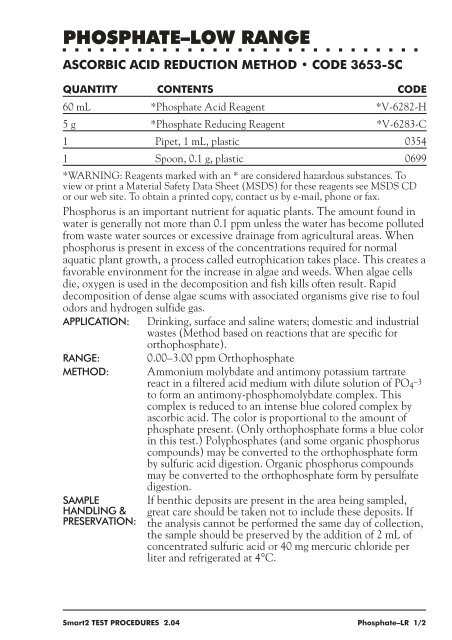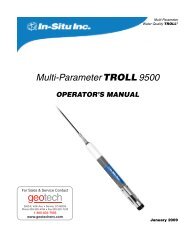TEST INSTRUCTIONS - Geotech Environmental Equipment
TEST INSTRUCTIONS - Geotech Environmental Equipment
TEST INSTRUCTIONS - Geotech Environmental Equipment
You also want an ePaper? Increase the reach of your titles
YUMPU automatically turns print PDFs into web optimized ePapers that Google loves.
PHOSPHATE–LOW RANGE<br />
ASCORBIC ACID REDUCTION METHOD CODE 3653-SC<br />
QUANTITY CONTENTS CODE<br />
60 mL *Phosphate Acid Reagent *V-6282-H<br />
5 g *Phosphate Reducing Reagent *V-6283-C<br />
1 Pipet, 1 mL, plastic 0354<br />
1 Spoon, 0.1 g, plastic 0699<br />
*WARNING: Reagents marked with an * are considered hazardous substances. To<br />
view or print a Material Safety Data Sheet (MSDS) for these reagents see MSDS CD<br />
or our web site. To obtain a printed copy, contact us by e-mail, phone or fax.<br />
Phosphorus is an important nutrient for aquatic plants. The amount found in<br />
water is generally not more than 0.1 ppm unless the water has become polluted<br />
from waste water sources or excessive drainage from agricultural areas. When<br />
phosphorus is present in excess of the concentrations required for normal<br />
aquatic plant growth, a process called eutrophication takes place. This creates a<br />
favorable environment for the increase in algae and weeds. When algae cells<br />
die, oxygen is used in the decomposition and fish kills often result. Rapid<br />
decomposition of dense algae scums with associated organisms give rise to foul<br />
odors and hydrogen sulfide gas.<br />
APPLICATION: Drinking, surface and saline waters; domestic and industrial<br />
wastes (Method based on reactions that are specific for<br />
orthophosphate).<br />
RANGE: 0.00–3.00 ppm Orthophosphate<br />
METHOD: Ammonium molybdate and antimony potassium tartrate<br />
react in a filtered acid medium with dilute solution of PO4 –3<br />
to form an antimony-phosphomolybdate complex. This<br />
complex is reduced to an intense blue colored complex by<br />
ascorbic acid. The color is proportional to the amount of<br />
phosphate present. (Only orthophosphate forms a blue color<br />
in this test.) Polyphosphates (and some organic phosphorus<br />
compounds) may be converted to the orthophosphate form<br />
by sulfuric acid digestion. Organic phosphorus compounds<br />
may be converted to the orthophosphate form by persulfate<br />
SAMPLE<br />
HANDLING &<br />
PRESERVATION:<br />
digestion.<br />
If benthic deposits are present in the area being sampled,<br />
great care should be taken not to include these deposits. If<br />
the analysis cannot be performed the same day of collection,<br />
the sample should be preserved by the addition of 2 mL of<br />
concentrated sulfuric acid or 40 mg mercuric chloride per<br />
liter and refrigerated at 4°C.<br />
Smart2 <strong>TEST</strong> PROCEDURES 2.04 Phosphate–LR 1/2

















